In the past month, the hail has damaged vineyards in several winegrowing areas in Europe, and for this reason, we are sharing practical advice on how to protect vineyards from hail and how to manage grapevines after hail damage.
Due to climate changes, winegrowers all around the world are faced with several unpredictive weather events. Not only that late spring frost occurs more often, but also hail storms became more and more constant. Hail can cause severe damage in the vineyard, not only in terms of quantity and quality of harvested grapes, but also in sense of grapevines survival and long-term development of vineyards.
Hail Damage on Grapevines
Hail can causes significant damage to leaves, stems, shoots, flower clusters and fruits. Leaves, flowers or fruits can be ether damaged or knocked to the ground, leaves can be bruised, torn, or holed; while shoots and trunk can be broken or have cracks.
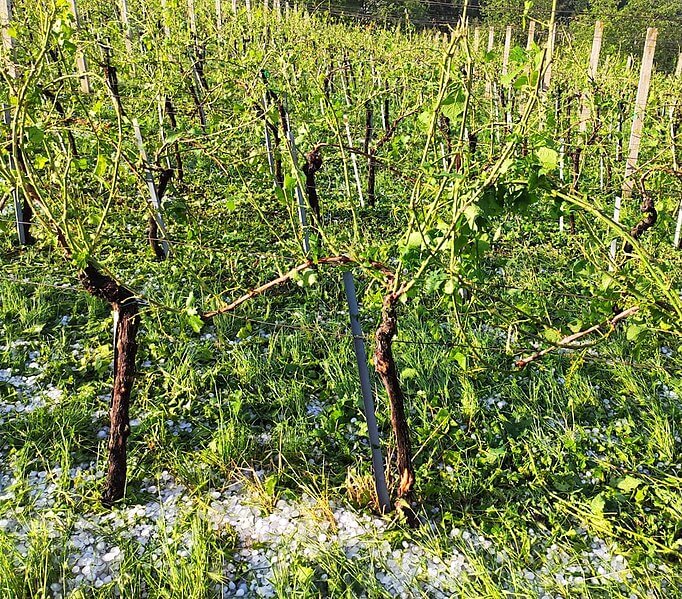
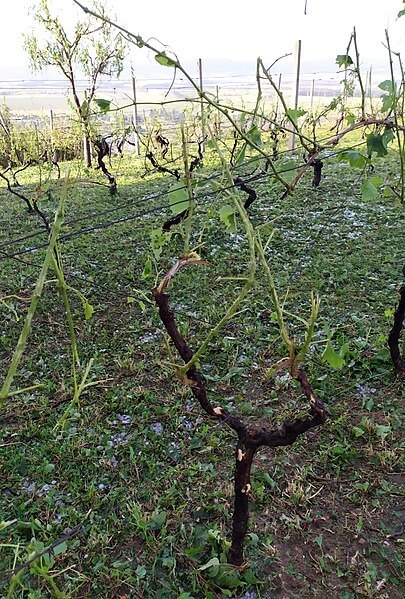
Hail can reduce the crop, number of shoots and leaf wall, and partly or totally stops the normal flow of nutrients. As a result, a hail with over 50% damage suppresses the growth and development of remaining clusters by up to 20 days, while milder hail distracts the growth processes for about 10 to 14 days. At the same time, lateral shoots start to develop more intensively. For this reason, apart from the reduced yield, the hail can result in a crop of lower quality. That’s why it’s important to stimulate the growth of canopy and nutrients uptake after the hail damage.
A very common issue of fruit injuries is also the development of Botrytis, due to the damaged epidermis.
In case hail damage vineyards before grapevine form next year’s buds, there is still enough time for the plant to recover by winter, but in case hail damage vineyard in this critical period of grapevine development, damage can become dangerous for the survival of the grapevine.
How to protect vineyards against hail?
Spring and summer hail may be prevented by:
- using anti-hail rockets and aircraft. This protection is questionable from an ecological and an economic point of view, and because of the incomprehensible performance in the long run, in some areas of the world it is being abandoned. This technique is successful only in narrower areas, and requires very good technical compatibility and organization. A drawback of this protection is that the possibility of hail is not completely excluded, therefore hail can still fall, but make less damage.
- Using hail nets. This is the most reliable and important form of protection for commercial vineyards in the long run.
Spring and summer damage by hail can be reduced by:
- choice of the appropriate sites that are less susceptible to hail (less often affected by hail),
- careful selection of vine variety, training and planting system. Grapes of more vigorous varieties are less damaged by the hail,
- any canopy management practices should be carried out with great care.
Managing grapevines after hail damages
Management of grapevines after hail damage depends on grapevine development stage and severity of hail damage. And based on that, the vineyard hail recovery management practices should be chosen. Grapevine has the ability to recover from hail, and it’s on grape-growers to properly manage vineyard after hail and help grapevine to recover faster. If hail damages are not extensive, then the grapevine will recover quickly.
Some practical advice in case hail already damaged grapevines:
- It’s recommended to asses the damage as soon as possible after the hail event, and then act upon it. If you have insured your vineyards, call the insurance and arrange all the formalities.
- As quickly as possible after the hail, protect grapevines with spraying that on one hand protects grapevines against diseases and at the same time help grapevines to heal; use plant protection products that contain folpet. In vineyards that still have leaves at the same time add bio-simulatns rich in humic acids which will promote leaf and shoot development. Foliar fertilizer that contains microelements and amino acids helps grapevines in stressful situations. Ensure good coverage. In case hail occur after the harvest, you can use also copper-base products to help grapevine wood to mature as quickly as possible to prevent winter frost damage. In vineyards where no leaves are left on the grapevine after hail, use the foliar application after grapevines start to re-grow.
- In case grapevine bunch stems are damaged by hail, crop can be extensively infected by Botrytis rot, and that’s why protection spraying against Botrytis infections should be applied right after hail damage and before any further wet event.
For the survival and regrowth of the grapevine that was damaged by hail, grapevine health, age and the way it was managed, play an important role.
Hail damage up to 50%
If hail damage are up to 50%, lower yield, as well as lower quality, can be expected, except if you can ensure a selective harvest. However, hail damage of less than 50% can be successfully repaired with increased costs, while in the next year normal harvest can be expected.
Vineyard management after hail damages by up to 50%:
- as quickly as possible protect grapevines against diseases and support re-growth with appropriate spray products
- no additional prune-back is recommended, simply leave the grapevine to recover and grow on its own
- ensure grapevine protection against key pests and diseases until the end of the growing season
Hail damage over 50%
In case of extreme hail damage, not only that the crop is damaged, but also the existence of the whole grapevine can be questionable. If hail occurs early in the season, a grapevine can still recover its injuries until the winter. If all shoots were stripped, grapevine will re-burst from secondary buds, and also a small crop can be expected. While, if extensive damages of clusters occur, winegrowers can drop-off all the remaining clusters in order to reduce the plant stress. Then, prune back injured shoots to promote the development of lateral shoots, which will allow the production of healthy and fruitful canes for the next season’s harvest.
Vineyard management after hail damage over 50%:
- as quickly as possible protect grapevines against diseases and support re-growth with appropriate spray products
- prune-back damaged shoots/canes
- ensure grapevine protection against key pests and diseases until the end of the growing season to ensure healthy shoot growth
In the worst-case scenario, if shoots and lateral buds are significantly damaged, remove damaged shoots down to the basal buds and leave grapevine to re-shoot and develop from secondary buds. This will allow burst from secondary buds and develop healthy canes for the following season. Make sure new shoots and canes develop properly by the end of the season for the grapevine to survive the winter. Do not expect any ripen crop in this season, grapevine with little or no crop can regrow faster. Hail around or after flowering will reduce fruitfulness and crop in the following season. Also, dormant pruning may need to be adjusted to obtain sufficient buds for next season crop.
Note that even though you decided not to harvest the crop as it was damaged by hail, continue with basic preventative spray program to protect grapevines against Powdery and Downy mildew and Botrytis, as you want to grow healthy foliar to ensure grapevine to produce and store all the necessary carbohydrate reserve for the following season. If also trunk or cordon got damaged, consider also spraying against trunk diseases.
TLDR: Hail in vineyards – damage, protection methods and management practice
In case vineyards got damaged by hail, winegrowers need to first asses damage and then choose an appropriate vineyard management strategy based on those damage. After the hail as soon as possible protect grapevines against pests and diseases, and make sure that grapevine re-grows properly. Retain healthy canopy until the end of the season for the grapevine to survive the winter and ensure following season growth.
Sources:
- Recovery from Hail Damage – Grapevines by John Whiting, Farm Services. October 2012. Agriculture Victoria State Government
- Hauptman S. et. all. 2011. Tehnološki ukrepi za sanacijo po neurju s točko. KGZ Maribor.
- What to do in case of hail damage of vineyards, by Wendy McFadden-Smith and Kevin Ker
- Managing grapevines after hail damages. Fact Sheet Viticulture 2015, AWRI.
- Featured image: Ivica Samardžić; via Wikimedia Commons [online]

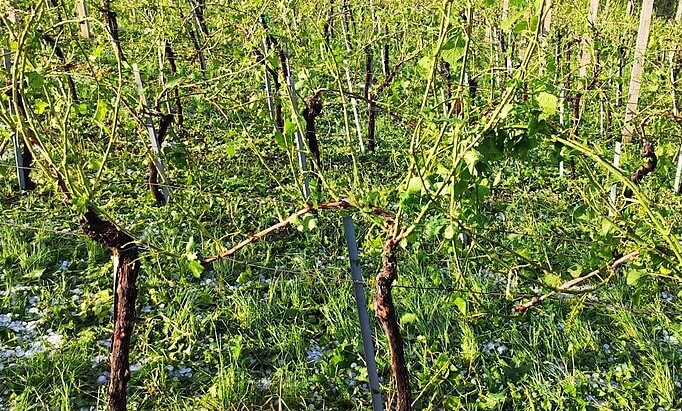
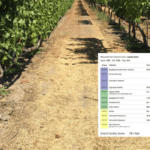

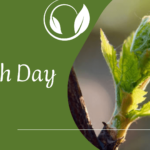
2 responses to “Hail in vineyards – damage, protection methods and management”
Very interesting Urska,
I have dealt with severe hail damage in vineyards twice in the last 20 years. I have found that the same nets you may use to exclude birds can be very useful in protecting vines from hail damage when fruit is ripening and no further protective sprays are required.
Regards
Rod.
Hi Rod, indeed there is no need to buy several nets, as long as they can hold the hail. Have to say you are lucky, some winegrowers are dealing with several hail storms in one growing season – depends on the area and year. This summer for example is particularly “unfriendly” for winegrowers in central Europe.